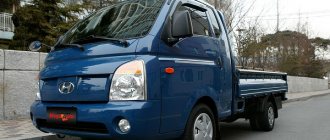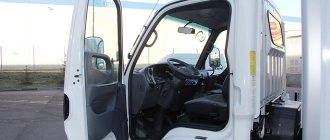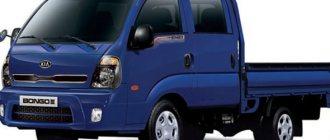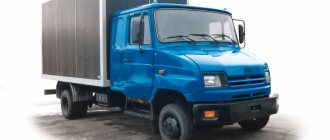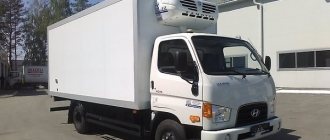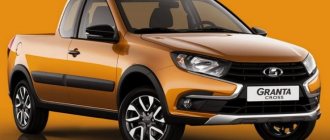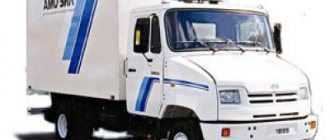Transporting perishable products in a city is a rather difficult task, since the use of large-sized transport is not always practical and convenient. Small-sized vehicles equipped with heat-insulating bodies come to the rescue. An example of such a vehicle is the Hyundai Porter 2.
Design
The design of the model is unique. Soft plastic trim decorates the car, making it elegant and attractive.
The complete package includes:
- electric windows;
- air conditioner;
- radio training.
The basic equipment requires the presence of power steering. Not everyone is comfortable in the cabin. Comfortable, soft seats in the Hyundai Porter 2 are suitable for two people. However, even this negative feature brings greater comfort than, for example, that of Hyundai’s competitor, the Ford Transit. Electronics have not reached the maximum level. There are no adapted tablets, displays or computer devices in the car. A nice feature is the backlight on the ignition switch. This allows for greater visibility at night and is a great design touch.
The car, by comparison, resembled a “tadpole” due to its rounded cabin. The driver's seat is made as comfortable as possible. The complete set includes lumbar support. The interior has built-in dials that are easy to read and understand. However, they do not have a particularly fashionable and impressionable design. The basic equipment of the Hyundai Porter 2 (TagAZ) includes excellent sound insulation. This allows you to operate the car pleasantly and with pleasure.
Modifications
At first, all modifications were 90% borrowed from Mitsubishi. Then the modifications started from Hyundai Grace and Hyundai Sonata. The brand model displayed its innovations in the formation of the bumper, headlights, and cabin. The cabin was rounded, which made it different from most.
Round headlights and an enlarged bumper were the basis of the modification, about 1991. For consumers, the Hyundai Porter 2 was presented as a 3- and 4-door van and a 2- and 4-door cargo vehicle. The manufacturer has provided this choice for a larger assortment, since the classic option does not always suit everyone.
The modification shown in 2004 has been updated with a headlight unit. If we take into account the functional features, the car has retained them. The lines of the cabin have changed. They became smoother, which added elegance. The new modification began to compete with many European cars, both in design and performance.
The latest modification of Porter 2 (TagAZ) is distinguished by its production in Brazil, Korea, Malaysia and Pakistan. This model was called Hyundai H-100. The device had a diesel engine as standard with a capacity of 123-133 horsepower. The model has both double and single cabins.
Modification of vans:
- Manufactured goods;
- Isothermal.
A manufactured goods van is designed to transport industrial goods so that the cargo is hermetically protected. Thanks to this modification of the van, water, dirt and dust do not get inside, which protects the product without harming its presentation. The insulated van maintains the temperature.
Model history and purpose
Hyundai Porter has been produced since 1977. Initially, the model was intended for the domestic market and was not exported. The HD1000 model was produced in 2 modifications (minibus and truck). The debut Hyundai Porter was a copy of the Mitsubishi L300 (Delica) and was produced under license purchased from a Japanese company. The release of the first generation was completed 4 years after its appearance. The vehicle was positioned as a small commercial vehicle with a load capacity of 950 kg, intended for transporting a variety of cargo on small streets with dense traffic.
Production of the second generation Hyundai Porter did not begin immediately. The Korean auto giant was working on improvements for the truck; rebranding happened only in 1986. However, the model again did not become independent. Like its predecessor, it was produced under a license purchased from a Japanese brand, and was an analogue of the Mitsubishi L300 (Delica), copying its more famous “brother”. Initially, the second Hyundai Porter was produced in 2 modifications (minibus and truck), but then versions with an extended wheelbase and a double operator’s cab appeared. The model was removed from the production line in 1995. It was not possible to buy the second generation in Russia.
In 1996, the third generation of the truck debuted, officially called the Hyundai Porter. Its production continues in some countries to this day. The car was strikingly different from its predecessor and became a completely independent product of the Korean brand. The steering mechanism in the Hyundai Porter was migrated from the Hyundai Sonata, and the dashboard was from the Hyundai Grace.
A special feature of the model was the ability to assemble it like a construction set. A variety of bodies and equipment were installed on the chassis. In this case, the panels of the operator's cab were carefully adjusted, and there were no gaps. The rounded shapes added aerodynamics to the truck. The appearance of the third Hyundai Porter turned out to be very memorable. The voluminous operator's cabin, slightly protruding bumper and large round headlights made the car look like a “tadpole”. Separate elements made it possible to replace parts by part, which significantly reduced repair costs. The base model came in 2- and 4-door truck and 3- and 4-door van versions. In addition to the modification with a load capacity of 950 kg, there was a variation with a load capacity of 1200 kg.
The third generation Hyundai Porter was supplied to the Russian market, where it was very popular. In 2005, TagAZ and Hyundai agreed to cooperate, and production of the truck opened at a domestic plant. A year later, the model received the title of “Best Commercial Truck” in Russia. The domestic variation of the Hyundai Porter was developed taking into account harsh climatic and road conditions. The car was equipped with a reinforced suspension, a galvanized body with anti-corrosion treatment and increased ground clearance. The engine used was a 2.5-liter diesel engine.
Since 2005, production of the fourth generation Hyundai Porter began in South Korea, receiving the index II. The novelty immediately attracted the interest of organizations involved in freight transportation. The body design has become more dynamic due to the replacement of rectangular headlights with round ones, the appearance of smoothed contours and an enlarged windshield. In terms of equipment and finishing, the fourth generation Hyundai Porter resembled passenger cars and was distinguished by the significant quality of fit and assembly of elements.
The car's engine range has been revised. It includes turbocharged 2.5-liter diesel units and a 2.4-liter gasoline engine that meet the requirements of Euro 3, Euro 4 and Euro 5. The list of additional options offered by the manufacturer has expanded. Hyundai Porter could be equipped with foglights, central locking, heated mirrors and full power accessories. The model was produced with a single and double operator's cabin. The car began to be delivered to the Russian market only in 2012.
The compact truck gained great popularity among domestic consumers and became the main foreign competitor to the Gazelle. The ability to use on busy streets and high build quality have become the main advantages of the model. These qualities forced many to choose in her favor. Hyundai Porter was used for transportation on intercity and intracity routes. The presence of many specialized modifications (manipulator, lift, isothermal van, emergency vehicle and others) made the scope of the model very wide. At the same time, the car showed itself everywhere as a reliable partner, capable of performing the most complex tasks.
Cabin Hyundai Porter 2
One of the advantages is the high build quality. The frame structure from which the car is made is quite strong, which will not make you doubt its reliability. The cabin is located above the engine. It is spacious and wide, which makes you feel comfortable in it. The cabin has three seats, which distinguishes the car from many competitors. The structure is made of steel, so the body will last a long time.
There are modifications that consist of 1.5 or 2 cabins. Although the car is for three passengers, it is advisable to ride in it together. The seat in the middle is most often used as a table. For two, Hyundai Porter 2 (TagAZ) will be an ideal option in terms of comfort. In terms of comfort and quality of interior trim, Hyundai is not inferior to a passenger car. The seats here are independently adjustable. There is also lateral support on the chair, which adds to the comfort.
The plastic that the body is equipped with is pleasant and strong. All instruments are located so that the driver can quickly navigate and this does not cause him problems. There is climate control, which is adjusted by sliders.
Engine and gearbox
| Engine model | D4BA |
| Volume | 2467 cm3 |
| Number of cylinders | 4 |
| Maximum power | 80 hp at 4200 rpm |
| Torque | 166 H*m at 2200 rpm |
| Transmission | 5-speed manual transmission |
| Acceleration to 100 km/h | 16.3 sec |
| Maximum speed | 160 km/h |
| Fuel consumption | 13 l |
| Volume of the tank | 65 l |
The engines of the car are equipped mainly with a diesel engine. The D4BF engine consists of 8 valves. It is located longitudinally. The installation complies with the Euro 3 environmental class. The engine was developed based on the Mitsubishi 4D56 unit.
Characteristics of Hyundai Porter 2:
- volume – 2.47 l.;
- power – 80 horsepower;
- torque – 200 Nm;
- has 4 cylinders.
The engine is distinguished by its efficiency, since it consumes little fuel; in addition, it has power qualities capable of transporting a decent load.
The gearbox is 5-speed. Speed changes are easy, smooth and precise.
Hyundai Porter 2
Light-duty universal truck Hyundai Porter 2.Thanks to its compact dimensions, very high maneuverability and compliance with the requirements for urban transportation, it is ideal for use in the city. The minimum loading height in its class greatly facilitates loading and unloading operations. To drive this truck, a license of category “B” and even “B” with automatic transmission is sufficient.
Hyundai Porter 2 is ideal, reliable and time-tested. In 2004, it replaced the popular Hyundai Porter model, which had been produced since 1987, including in Russia at the TagAZ plant in Taganrog. This modern and comfortable car is intended primarily for commercial needs.
The cabin of the Hyundai Porter 2 with enlarged headlights remains three-seater, as in the previous model. Thanks to double adjustment (longitudinal and backrest tilt), the driver now has the opportunity to perfectly adjust the seat to his needs. The passenger can only adjust the seat backrest angle. The manufacturer has equipped this modern car with an economical engine running on diesel fuel. As professional experts note, driving the Hyundai Porter 2 has become easier and more enjoyable.
Restyling 2012
In 2012, the company's designers updated the restyling. The shape of the fog lights and front bumper has undergone significant changes. The headlights have also changed, making them look much more expressive. The diameter of the rear wheel has also increased, now it is 13 inches. There were no significant changes in the engine design; it remained practically unchanged: the same volume - 2.5 liters. with intercooler and turbocharging, but the power reached 133 hp. With.
The most important change in the technical part of Porter 2 occurred with the gearbox, which became six-speed, thereby increasing the efficiency and dynamism of the car.
Starting from the second half of 2013, the Korean Hyundai plant began producing all-wheel drive cars (before that, only the KIA Bongo could be equipped with all-wheel drive), and the serial installation of an automatic transmission also began.
Restyling 2016
Since 2016, the cabin interior has been equipped with new generation controls. The instrument panel has improved ergonomics and updated interior trim to improve comfort. There are configurations with climate control.
HYUNDAI Porter 2 design is a revolution in the light truck segment
Powerful enough to handle almost any job, yet surprisingly economical to run. Compact enough to handle tight spaces, but with plenty of room for cargo and crew
MAIN CHARACTERISTICS:
| Drive: rear or rear with plug-in front |
| Cabin three types: Standard , Large - added in-cab luggage compartment, Double - 6-seater |
| ESC - Electronic Stability Control (electronic stability control)includes: ABS + TCS - anti-lock wheel system when braking and anti-slip system when accelerating EBD is a brake force distribution system that provides a minimum braking distance without skidding. BAS - Brake Power Assist during Emergency Braking HAC - Hill Start Assist Control prevents wheels from spinning when starting to climb up a slippery road and rolling backwards. |
| Service brake Tandem 15-inch front ventilated disc and rear drum brakes, paired with a booster, provide effective braking of the car even when fully loaded. Also, a stabilizer bar is installed at the front, which provides precise and responsive steering. |
| Power unit | |
| Model | D4CB |
| Type | 4-cylinder in-line 4-stroke diesel with turbocharging, intercooler, direct injection and water cooling |
| Number of valves | 4 valves per cylinder |
| Engine displacement | 2497 cm³ |
| Engine power | 133 hp at 3800 rpm |
| Torque | 26.5 kg.m. at 1250∼3500 rpm |
| Fuel system type | Common Rail |
| Transmission and drive | |||
| Wheel formula | 4x2 | 4x4 | |
| Gearbox type | 5-speed automatic | 6-speed manual | |
| Transfer case | absent | mechanical with range multiplier | |
| Power take-off | No | perhaps an additional option | |
| Clutch | No | Single disc dry with hydraulic control | |
| Control | |
| Steering | with power steering |
| Service brake | Hydraulic with vacuum booster |
| Parking brake | On wheels, with traction cable drive |
| Tires | ||
| Drive unit | 4x2 | 4x4 |
| Front | Single – 195/70R15C 8PR | Single -6.50R15 LT |
| Rear | Double - 145R13C 8PR | Single -6.50R15 LT |
BASIC VEHICLE EQUIPMENT
| Exterior mirrors Wide-format exterior mirrors provide excellent visibility, which increases safety while driving. Mirrors are electrically adjustable and heated | Electrical equipment Electric windows, central locking - all these are small details, but without them comfort and safety would be incomplete |
| Headlights Good light is one of the components of safe night driving, so the headlights of your HYUNDAI PORTER 2 are equipped with halogen lamps and multi-focus reflection technology, which makes the projection of light clearer, wider and more accurate. | Fog lights Increase driving safety in bad weather conditions. PTFs are recessed into the bumper, which protects them from accidental damage. |
| Frame Rigid frame made of steel profile 100x50 mm with double wishbones, torsion bar front and rear spring suspension ensure the reliability and safety of the car | Heating and air conditioning Adjustment of air flow and temperature (air conditioning IN ALL trim levels) ensures comfort in the cabin all year round |
| Fuel tank protection Lockable with a key or openable from the cab (depending on configuration) the fuel tank cover prevents theft of fuel and the entry of foreign substances into the tank | Hood The engine compartment contains washer and coolant fluids, a cabin filter, as well as fittings for charging refrigerant into the air conditioning system. |
| Maintenance-free battery Maintains density and charge over a long period of use | Toolbox Lockable outer box to transport and protect your tools and other small items |
| Limited-Slip Differential (LD) Driving on muddy, uneven or unpaved roads may result in loss of traction and control of the vehicle. A locking differential ensures you get maximum traction. It engages automatically when needed and is more efficient than a limited slip differential (LSD) |
Versatility The ability to choose between a long wheelbase, cab type and configuration, drive and transmission type, as well as a large selection of installed add-ons - allows you to satisfy any needs for your business
Color options:
| Onyx Blue ZA | Creamy White YAW |
Chassis
The rear suspension consists of springs that help withstand heavy loads. To get rid of unnecessary vibrations and give stability to the car, telescopic shock absorbers are installed. Because of this feature, Hyundai Porter 2 (TagAZ) is suitable for off-road use. The front suspension is independent. It is equipped with a stabilizer bar.
The brakes operate on the basis of a dual-circuit system with a vacuum booster. This mechanism is divided into circuits, which improves the braking process. Drum brakes are installed on the rear wheels. A characteristic feature of the model’s braking system is tenacity.
The steering mechanism for the car is based on the rack and pinion principle. To make it easier to control, power steering is equipped, which comes in addition to the basic configuration.
Fuel consumption of Hyundai Porter according to owner reviews
In addition to stunning dynamic characteristics, the Hyundai Porter also boasts high cross-country ability. This car is easy to drive, responsive and maneuverable. The manufacturer decided to equip the “porter” with front independent spring suspension and rear springs. Hydraulic telescopic shock absorbers help to comfortably overcome all irregularities. Among other things, Porter's chassis also includes an anti-roll bar. It is for its thoroughly thought-out and high-quality chassis that many domestic drivers give preference to the Hyundai Porter when choosing a commercial vehicle. What is the actual fuel consumption of a car per 100 km? Owner reviews will tell you about this.
Turbodiesel 2.5
- Vasily, Voronezh. Hi all! I have a 2007 Hyundai Porter 2 manufactured by TagAZ. During all this time, I have already clocked up 300 thousand kilometers. The car is ideal for those who are engaged in trade or delivering cargo. For a long time I drove a GAZelle, but at one point I decided to change to something new. But the Korean modification did not have enough funds, so I decided to purchase a domestic assembly. And I didn’t regret it at all. Fuel consumption in the city in the warm season is 11.2 liters, and in winter 11.7 liters. What surprises me and at the same time makes me happy is that all year round there are practically the same figures for the cost of diesel fuel. On the motorway it consumes about 8 liters per hundred!
- Sergey, Moscow. All I can say is that this is a great car for entrepreneurs. I drive a Hyundai Porter 1, I have changed the timing belt, water pump, front shock absorbers and crosspiece several times. During all this time, I drove the Porter almost all over Russia, and I never had any problems with the engine on the road. Modification with an isothermal booth, very reliable and practical. There are no complaints about diesel fuel consumption: on average, in summer it burns 10-11 liters per 100 km, in winter a maximum of 1 liter more, but in rare cases the figures exceed the official norm. The cabin is warm, the diesel engine starts in a jiffy even at 20 degrees below zero!
- Alexey, Kazan. I’ve already spent a whole year behind the wheel of a Hyundai Porter 2. As you know, the second generation is still being produced. I purchased a new car, and during this period I covered 40 thousand kilometers. I load approximately 1.2-1.5 tons, the springs are reinforced, so more is possible, but I don’t risk it. The chassis is excellent, so far no unnecessary sounds. Consumables included changing filters and, of course, engine oil. Diesel is very high-torque, no matter how much it is loaded, it pulls the same. Now, actually, in terms of diesel fuel consumption: I often drive 40% in the city and 60% on the country road. Consumption is stable at 11 liters per hundred, I fill it with diesel fuel at Lukoil, and change Mobil 5W40 oil every 10 thousand kilometers.
- Mikhail, Taganrog. When the need arose to purchase a truck, I didn’t think for a long time, I immediately decided to get a Hyundai Porter assembled by TagAZ. As of today, the mileage is 70 thousand km, so far I am happy with everything, however, they said during the diagnostics that the time will soon come to change the turbine. Consumption according to the on-board computer is on average 10-11 liters, when loaded to failure, it can be a little more than the norm 11.5 liters, once it was 12 liters, but then it was stuck in traffic for a long time. The amount of diesel fuel burned mainly depends on the driving style; personally, I drive carefully, so there were no breakdowns, and the efficiency indicator makes me happy. Those who prefer to drive differently will probably have different numbers.
- Sergey, Tyumen. My partner and I have been riding Porter 2 for a little over a year. Basically, 60% of the time we travel on highways, and about 40% of the time is spent in urban travel. The average consumption according to the computer is 11 l/100 km, on the highway we stick to a speed of 85-95 km/h, modification with a booth, a fairing is also installed. I don’t even know what to say regarding consumption. My partner says that for such a car 11 liters is the norm, but I think that for such a driving mode it is too much. A good friend of mine works at another company, they also have a Hyundai Porter 2, and he says that it never gets more than 10 l/100 km, neither in winter nor in summer. So I’m thinking, why is there such a difference, and, in general, what is the expense for other owners?
Reviews from owners of Hyundai Porter of all three generations confirm the high reliability and practicality of the truck. The car feels great both on city roads and on highways. At the same time, the Porter can be easily maneuvered in tight streets and parking lots of large stores. Another advantage of the car is its high efficiency. With a dead weight of 2.5 tons and the ability to transport cargo weighing 950 - 1250 kg, the Hyundai Porter consumes on average 8 liters of diesel fuel while driving on highways, and 11 liters in urban conditions.
Price Hyundai Porter 2
The cost of the car reaches 950,000 rubles. For some this seems like a huge price, but for a car of this class this is normal. For those who cannot afford a million rubles, there are supported options.
Price list of supported models:
- 2007 – up to 300,000 thousand;
- 2011 – up to half a million rubles;
- 2014 – up to 800,000.
The price may vary not only from the year of manufacture of the machine, but also from the condition and method of transportation of the unit.
Malfunctions
If you take the general impression of the car, you will see more advantages. However, each device has its own glitches and problems.
Porter faults:
- Idle speed does not hold well over time;
- Weak, slow acceleration after prolonged use;
- The engine begins to stall;
- Difficult to start in cold weather;
- Frequent problems with belt tension.
In order to avoid problems associated with operation, you need to periodically visit a car service center. They will check the oil changes and also replace the coolant.
Among other problems, the battery may become dirty, after which the contacts will oxidize. The machine's center of gravity is also high, which can cause it to overturn in rare cases. Vans have this negative quality.
Hyundai Porter 2 (TagAZ) boasts its versatility, mobility and practicality. It combines the functions of a truck, but is not inferior to a passenger car in terms of comfort and quality of control. Its popularity on the world market and in the Russian Federation is explained by its high quality and reasonable price. The product does not require expensive maintenance; in addition, it is easy to find the necessary spare parts and components for the car. Profitability also consists in low fuel consumption compared to similar representatives of trucks.
Specifications
The technical specifications of the Hyundai Porter are given below:
- curb weight of the car - 1864 kg;
- total permissible weight - 3160 kg;
- turning radius (min) - 4.7 meters;
- wheelbase (standard version) - 2.43 meters;
- track width - 1.49 m front, rear - 1.32 m.
Load capacity
The Porter's carrying capacity has undergone changes compared to the first generation and increased from 950 to 1000 kilograms. But in everyday reality, this “workhorse” takes up to 1,300 kilograms of cargo without loss of engine torque; overload has virtually no effect on the dynamics even when driving on inclines. This is also possible thanks to the leaf spring rear suspension with available telescopic hydraulic shock absorbers.
It is not worth systematically overloading the car due to the fact that the 165 R12-PR rear tires may not withstand the load. This type of tire is not produced in Russia, so the cost of replacing tires is quite high and is reflected in the cost of transportation.
dimensions
In the standard version, the dimensions of the Hyundai Porter are as follows:
- length - 5.12 meters;
- width - 1.74 m;
- height along the awning - 1.965 m.
In the Long version, the length increases to 5.36 meters, and in the Extra-Long modification it is 6.11 meters. You can install different vans on the chassis, and the sizes of the 1st or 2nd generation Porter booth will be very different. You can vary both the height of the booth and its length, it depends on the nature and weight of the goods being transported. With light loads, the volume of the body can be significantly increased, and this is also an advantage of this truck with many modifications.
Engine
The Huyndai D4CB 2.5 CRDi four-cylinder turbocharged engine offers good performance. It has been produced since 2001, but during this time it has been modernized three times. The latest version, installed on Porters 2, belongs to the modern Euro-5 class in terms of environmental friendliness. This engine is 16-valve and produces a torque of 314 N.m.
The power of the engine is 133 hp, and with excellent torque, it consumes only 11 liters of diesel fuel per 100 kilometers in the combined cycle. The manufacturer's fuel consumption data has been verified by numerous customers and is fully confirmed. In the urban cycle, fuel consumption increases to 13 liters. The motor block head is made of aluminum alloy, the block itself is cast iron, and the hardened valves are made of steel. The engine is very reliable and has a high mileage.
In addition to the standard 5-speed manual transmission, the Porter can be equipped with a 6-speed manual transmission and even a 5-speed automatic transmission. But in practice, the standard version is more used; it is reliable and unpretentious in operation, including under overload conditions.
Chassis
The front suspension of the Porter car is independent and uses springs, unlike the rear suspension, which is dependent and uses springs. There are wishbones and stabilizer bars at the front. Tire size: front - 195 R15-PR, rear - 165 R15-PR. Newer Porter cars have 13-inch wheels at the rear. There is a reliable multi-section frame of increased rigidity, which allows the Porter to be equipped with extended cabs and various body options.
Other characteristics
The car has ventilated disc brakes at the front and drum brakes at the rear. There is a vacuum booster for the rear brakes. This machine has a mechanical parking brake system, where the rear axle pads are released.
In addition to a fairly rich standard package, such a car is often equipped with parking sensors to reduce the likelihood of damage during unloading, an adjustable steering column, an automatic driver's window and other useful options. All of them can be ordered additionally or you can select the appropriate configuration.


